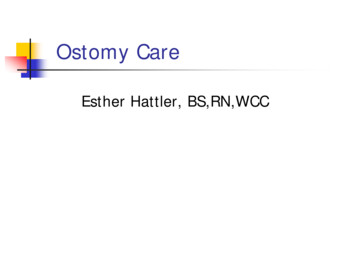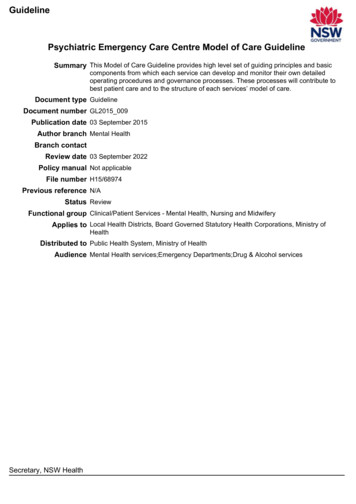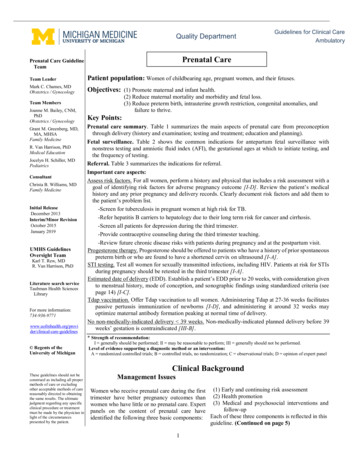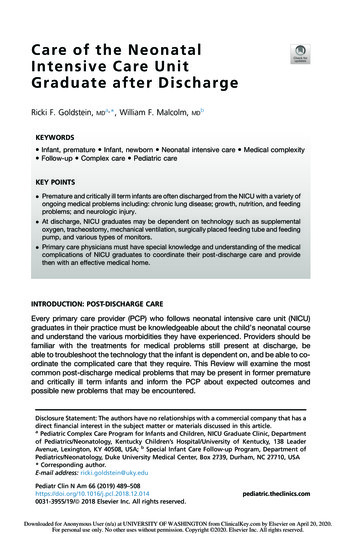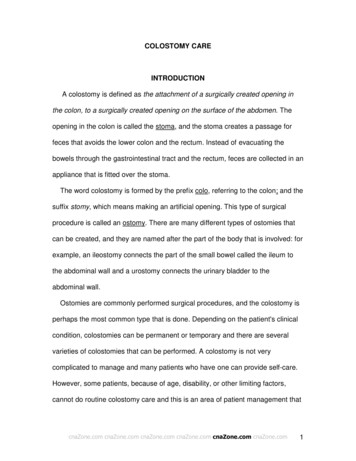
Transcription
COLOSTOMY CAREINTRODUCTIONA colostomy is defined as the attachment of a surgically created opening inthe colon, to a surgically created opening on the surface of the abdomen. Theopening in the colon is called the stoma, and the stoma creates a passage forfeces that avoids the lower colon and the rectum. Instead of evacuating thebowels through the gastrointestinal tract and the rectum, feces are collected in anappliance that is fitted over the stoma.The word colostomy is formed by the prefix colo, referring to the colon; and thesuffix stomy, which means making an artificial opening. This type of surgicalprocedure is called an ostomy. There are many different types of ostomies thatcan be created, and they are named after the part of the body that is involved: forexample, an ileostomy connects the part of the small bowel called the ileum tothe abdominal wall and a urostomy connects the urinary bladder to theabdominal wall.Ostomies are commonly performed surgical procedures, and the colostomy isperhaps the most common type that is done. Depending on the patient's clinicalcondition, colostomies can be permanent or temporary and there are severalvarieties of colostomies that can be performed. A colostomy is not verycomplicated to manage and many patients who have one can provide self-care.However, some patients, because of age, disability, or other limiting factors,cannot do routine colostomy care and this is an area of patient management thatcnaZone.com cnaZone.com cnaZone.com cnaZone.com cnaZone.com cnaZone.com1
certified nursing assistants (CNAs) and Home Health Aides (HHAs) are oftenrequired to perform. Colostomy care is considered to be a basic skill that allCNAs and HHAs should know.OBJECTIVESAfter completing this module, the learner will be able to:1. Identify the primary function of the colon.2. Identify the correct definition of a colostomy.3. Identify the two basic reasons for performing a colostomy.4. Identify the two basic types of colostomy.5. Identify the correct definition of a stoma6. Identify complications associated with a colostomy.7. Identify basic CNA/HHA responsibilities of colostomy care.8. Identify the infection control practices needed when providing colostomy care.9. Identify a procedure used to establish regular passage of feces.10. Identify activity and diet concerns of patients who have a colostomy.ANATOMY AND PHYSIOLOGY OF THE GASTROINTESTINAL TRACTThe gastrointestinal tract begins with the mouth and the oral cavity and endswith the anus. The two basic functions of the gastrointestinal tract are: 1) intakeand absorption of food and fluids, and; 2) elimination of wastes.The intake of food and fluids is begins in the mouth. Food is chewed andsalivary juices begin to break down the food into useable nutrients. The processcnaZone.com cnaZone.com cnaZone.com cnaZone.com cnaZone.com cnaZone.com2
continues with further breakdown and digestion of food in the stomach. After thestomach, the gastrointestinal tract continues with the small bowel. The smallbowel is a long, relatively narrow tube and most of the nutrients we eat such ascarbohydrates, fats, proteins, minerals vitamins, etc. are absorbed through thesmall bowel. The small bowel connects with the colon, which is also called thelarge bowel, and the colon connects with the rectum and the anus. Feces isformed and stored in the colon and expelled from the rectum and anus.The colon is approximately five feet long. It is located in the abdomen belowthe navel and above the pubic area, it extends across most of the stomach walland it is divided into four sections: 1) ascending colon; 2) transverse colon; 3)descending colon, and; 4) sigmoid colon. After food has been broken down bythe stomach and after the nutrients and most of the fluids have been absorbed bythe small bowel, the remainder of what we eat - and what cannot be digested passes from the small bowel into the colon. At that point, most of the remainingwater is absorbed through the wall of the colon and feces are formed. Theprimary function of the colon is to form and store feces, and it also absorbs oreliminated water as the needs arise.cnaZone.com cnaZone.com cnaZone.com cnaZone.com cnaZone.com cnaZone.com3
COLOSTOMIEScnaZone.com cnaZone.com cnaZone.com cnaZone.com cnaZone.com cnaZone.com4
As mentioned in the introduction, a colostomy is the attachment of a surgicallycreated opening on the colon to a surgically created opening on the surface ofthe abdomen. The opening in the colon is called the stoma, and the stoma andthe opening in the abdominal wall to which the stoma is attached are collectivelycalled the colostomy.Colostomies can be done in two ways. A loop colostomy is performed bytaking a loop of the colon, making a surgical opening along a point in that loop,and then using sutures to attach that part of the colon to a surgically createdopening, or exit point, on the abdominal wall. A terminal colostomy or endcolostomy is performed by completely cutting through the colon, taking the endthat has been created by this cut, and then using sutures to attach the resectedend of the colon to the surgically created opening, or exit point, on the abdominalwall. In either case, the result is the same; feces are diverted from the lowercolon, the rectum, and the anus and emptied through the stoma. Terminal/endcolostomies are preferred because loop colostomies are difficult to fit with a bagand they are more likely to prolapse (Note: Prolapse will be discussed later in themodule). Some colostomies are temporary and some are permanent.The primary function of a colostomy is to provide an alternative way of passingfeces. Colostomies are performed for the treatment of a wide variety of clinicalconditions, but the two basic reasons for performing a colostomy are rest anddiversion: some times these are both accomplished by a colostomy. Rest: If the colon becomes obstructed, feces cannot pass through and beeliminated. Also, there may be times when the colon is infected or injuredcnaZone.com cnaZone.com cnaZone.com cnaZone.com cnaZone.com cnaZone.com5
and needs time to rest and heal. A temporary colostomy can be done toallow the feces to be passed while the cause of the obstruction is beingcorrected. A temporary colostomy can also be done to allow the colon toheal after an injury or to rest while an infection is being treated. Diversion: Some times the colon or another part of the gastrointestinaltract is too damaged or diseased to be repaired and a part of it needs tobe removed. If the patient needs to have part of the colon permanentlyremoved, perhaps because of cancer in the colon, a colostomy will beperformed in order to allow the colon to function and for feces to beeliminated. This type of colostomy is permanent.Specific medical conditions that may require a colostomy to be performedinclude: Anal cancerChron’s diseaseColon cancerDiverticular diseaseFecal incontinenceRectal cancerAfter the colostomy has been performed, feces are eliminated through thestoma. Depending on what part of the colon was used to create the colostomy,the stoma will be located on the right side of the stomach, the upper part of thestomach and near the mid-line, or on the lower left side of the stomach. Forexample, if the stoma was created from the ascending colon it will be located onthe patient’s right side.cnaZone.com cnaZone.com cnaZone.com cnaZone.com cnaZone.com cnaZone.com6
The stoma is covered with an appliance. This appliance is a flat, transparent,flexible bag made of plastic. Most are about 5 inches wide and about 8-10 incheslong. The appliance has an opening that fits over the stoma and this part of theappliance is attached to the stomach wall by an adhesive. It also has an openingat the opposite end that is used to empty the feces.COLOSTOMY CAREMost people who have a colostomy do not have any significant limitations onwhat they can do. Aside from managing the colostomy, they live life exactly asthey did before the procedure was done. Because the feces is passed throughthe colostomy into an appliance instead of being evacuated through the rectum,someone who has a colostomy should make sure they drink plenty of fluids toavoid being constipated, avoid foods that can cause constipation or diarrhea,avoid foods that can cause gas, and take sensible precautions to protect thestoma from physical harm. The patient must also lean how to care for the stomaand use the colostomy appliances. Apart from those simple requirements,someone who has a colostomy can eat a normal diet and exercise as toleratedwithin the guidelines provide by their physician or other healthcare provider.Specific issues relating to living with a colostomy will be discussed later in themodule.But although though a colostomy does not put insurmountable limitations onlife style, a colostomy does require specific care. The person who has acolostomy is no longer passing feces through the gastrointestinal tract as she/hecnaZone.com cnaZone.com cnaZone.com cnaZone.com cnaZone.com cnaZone.com7
did prior to the operation. Instead, the feces is being passed through the stomaand collected in a pouch that is attached to the abdomen. Because of that thereare certain considerations and these impact your care of the patient. When youare providing colostomy care for a patient, you need to be familiar with: 1)emptying and changing the bag; 2) irrigation of the colostomy, and; 3)complications associated with colostomies, and; 4) how to assess a patient whohas a colostomy.Learning Break: Providing colostomy care does not require you to use steriletechnique. However, you should always use standard precautions when you arechanging or emptying the appliance, irrigating a colostomy, or performing anyother type of patient care.Emptying and Changing the BagThe feces that are expelled from the stoma are collected by an appliance; thisis also often called a bag or a pouch. There are several different types of bagsthat can be used to collect feces. Depending on where the colostomy is, whattype of feces is formed, and how regularly the feces is formed, the bag can havean opening at one end so that it can be emptied when the need arises, oroccasionally it can be a disposable bag that is removed and discarded when thisis needed. Most patients use a bag that is emptied and re-used and if the patienthas a lot of liquid feces that is formed irregularly and unpredictably, a bag thatcan be emptied is definitely the best choice. The bags are attached to the skincnaZone.com cnaZone.com cnaZone.com cnaZone.com cnaZone.com cnaZone.com8
around the stoma by using an adhesive ring that has a hole that fits over thestoma, and the bag is attached to the ring. The adhesive ring can be a separatepiece that is applied independently or it can be a part of the bag.It is recommended to change or empty the bag when it is about 1/3 to 1/2 full,but of course this recommendation can be adjusted as needed. The weight of abag that is too full can be distracting to the patient and although it is not likely tohappen, a bag that is too full can pull down on the adhesive attachment andbecome loose. A bag that is too full can also pull on the adhesive and irritate theskin.Emptying the bag is very easy and is done by following these eight steps.1. Wash your hands and put on disposable gloves.2. Open the end of the bag. Most bags are closed at the end by a simpleplastic clip.3. Let the feces drain into an acceptable container.4. If desired, the bag can be rinsed out with a large disposable syringe.5. Close the bag.cnaZone.com cnaZone.com cnaZone.com cnaZone.com cnaZone.com cnaZone.com9
6. Properly dispose of the feces Remove the gloves, dispose of themproperly, and wash your hands.7. Document the amount of feces that was emptied. If the feces wasespecially lose or watery or especially hard make sure to document this,as well.Changing a bag is also very easy and when you are required to do so, followthese five steps1. Wash your hands and put on disposable gloves2. Remove the bag from its attachment ring.3. Inspect the stoma and the skin around the stoma.4. Clean the area with a mild soap and water or with the cleaning agent thathas been recommended by the physician or other healthcare provider.5. If a barrier cream or powder has been ordered, apply it to the area aroundthe stoma. If cream or powder gets on the stoma, simply wash them offgently with gauze and water.6. Put a new bag in place. If the adhesive ring is separate from the bag, thiscan be changed, as well.There is a wide variety of colostomy appliances - adhesive rings, bags, skinprotectors, etc. - that can be used, and it is not possible to provide detailedinformation here about how to work with all the available types of colostomycnaZone.com cnaZone.com cnaZone.com cnaZone.com cnaZone.com cnaZone.com10
appliance and accessories. However, the basic process of changing andemptying a bag is the same regardless of the brand. Changing and emptying thebag will be done on a schedule that is determined by the ostomy nurse (The roleof the ostomy nurse will be explained later in the module), the physician, or bythe patient’s needs and/or preference. Checking the bag should be done at leastonce every eight hour shift, or according to the schedule that is specific to whereyou work or the patient’s needs.IrrigationPatients who have a colostomy in the descending or sigmoid colon may needto have the colostomy irrigated. Irrigation is a procedure by which an irrigationsolution - usually water - is introduced into the colon through the stoma. Irrigationcan help certain patients establish a regular pattern of elimination because theirrigation solution fills the colon and stimulates the movement of feces into theappliance.Irrigation is typically done an hour so after a meal, but the schedule forirrigation will vary from patient to patient. Irrigation is a relatively simpleprocedure and it can be done in several ways, but the basics of the
required to perform. Colostomy care is considered to be a basic skill that all CNAs and HHAs should know. OBJECTIVES After completing this module, the learner will be able to: 1. Identify the primary function of the colon. 2. Identify the correct definition of a colostomy. 3. Identify the two basic reasons for performing a colostomy. 4. Identify the two basic types of colostomy.File Size: 351KBPage Count: 24

